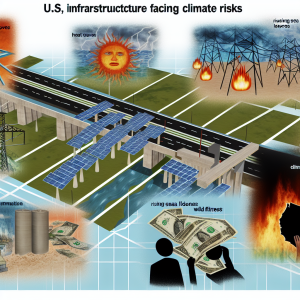U.S. Infrastructure Faces a Climate Crisis: What Investors Need to Know Now
The state of America’s infrastructure is no longer just a civil engineering concern—it’s a pressing climate and investment challenge with far-reaching consequences. The American Society of Civil Engineers (ASCE) recently gave the nation’s infrastructure a “C” grade, underscoring a sobering reality: our aging systems were built for a climate that has dramatically shifted, leaving them vulnerable to extreme weather events that are now the new normal.
Consider the dramatic scenes from 2023: Fort Lauderdale/Hollywood International Airport transformed runways into rivers during historic rainfall, halting operations and stranding thousands. Meanwhile, in New York City, a Harlem River bridge expanded under extreme heat to the point it got stuck open, disrupting critical transportation. These are not isolated incidents but symptomatic of a nationwide infrastructure system buckling under climate stress.
ASCE’s findings reveal that every infrastructure category—from airports to power grids and telecommunications—is increasingly at risk. A climate risk analytics firm, First Street, highlights that 19% of power infrastructure, 17% of telecommunications, and 12% of airports face significant threats from floods, wind, or wildfires. This is particularly alarming given these sectors’ crucial roles in economic stability and growth.
What does this mean for investors? The infrastructure investment landscape is entering a transformative phase. Traditional assets are now exposed to escalating climate risks, which can lead to operational disruptions, increased maintenance costs, and diminished asset values. Yet, this challenge also presents a unique opportunity for forward-thinking investors to capitalize on the urgent need for climate-resilient infrastructure.
Sarah Kapnick, JPMorgan Chase’s global head of climate advisory and former NOAA chief scientist, notes a growing trend among investors: “Clients are increasingly asking how to adapt their infrastructure investments to climate realities—whether through new construction standards, insurance strategies, or capital market access.” This shift signals that climate resilience is becoming a core criterion in infrastructure investment decisions.
From an advisory standpoint, the imperative is clear: integrate climate risk analytics into every stage of infrastructure investment evaluation. Investors should demand transparency on how assets are being adapted to withstand extreme weather and seek out projects that incorporate cutting-edge engineering informed by climate science. This means prioritizing infrastructure that is not only robust against current conditions but designed with future climate scenarios in mind—a concept known as “adaptive design.”
Moreover, the funding gap is staggering. ASCE estimates a $3.7 trillion shortfall over the next decade to bring U.S. infrastructure to a good state of repair. Yet, political headwinds persist. The cancellation of FEMA’s nearly $1 billion Building Resilient Infrastructure and Communities program under the previous administration exemplifies the volatility of public funding, making private capital’s role even more critical.
Here’s a unique insight for Extreme Investor Network readers: Beyond traditional infrastructure sectors, emerging technologies like smart grids, climate-resilient data centers, and flood-adaptive transportation hubs represent high-growth opportunities. For example, smart grid investments can reduce outage risks by dynamically responding to weather events, a crucial innovation as nearly one in five power infrastructures face high climate risk.
What’s next? Investors and advisors must:
- Incorporate Climate Risk Modeling: Use advanced analytics from firms like First Street to assess vulnerability across portfolios.
- Engage with Policymakers: Advocate for stable, long-term infrastructure funding that prioritizes resilience.
- Prioritize Adaptive Infrastructure: Focus on projects designed to evolve with changing climate conditions, reducing long-term risk.
- Diversify into Climate-Tech: Explore investments in technologies that enhance infrastructure resilience, such as AI-driven maintenance and green energy integration.
- Educate Clients: Help investors understand the financial implications of climate risk and the benefits of proactive adaptation.
In conclusion, the intersection of climate change and infrastructure is reshaping the investment landscape. Those who act now—leveraging science, technology, and strategic foresight—will not only protect capital but also drive the resilient infrastructure revolution. For investors seeking to stay ahead, ignoring these trends is no longer an option.
Sources:
- American Society of Civil Engineers (ASCE) Infrastructure Report Card 2023
- First Street Climate Risk Analytics
- JPMorgan Chase Climate Advisory Insights
Stay tuned with Extreme Investor Network for the latest in climate-resilient investing strategies and infrastructure trends that matter most to your portfolio’s future.
Source: Climate threat to U.S. infrastructure is accelerating

